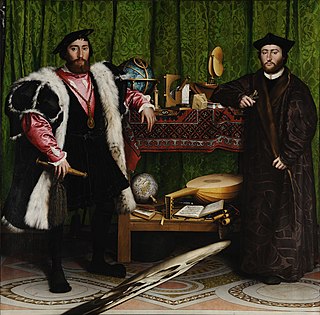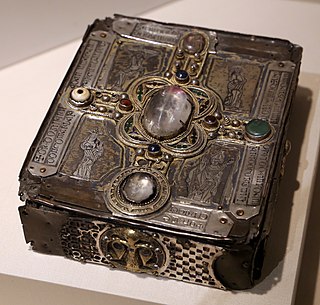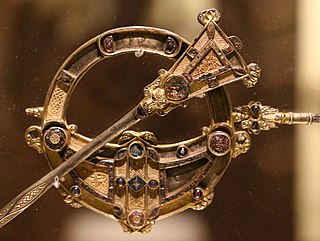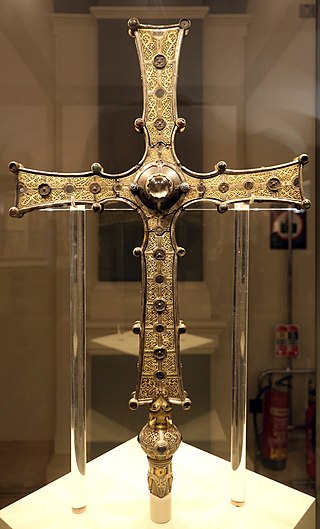Related Research Articles

Iconography, as a branch of art history, studies the identification, description and interpretation of the content of images: the subjects depicted, the particular compositions and details used to do so, and other elements that are distinct from artistic style. The word iconography comes from the Greek εἰκών ("image") and γράφειν.

A cumdach or book shrine is an elaborate ornamented metal reliquary box or case used to hold Early Medieval Irish manuscripts or relics. They are typically later than the book they contain, often by several centuries. In most surviving examples the book comes from the peak age of Irish monasticism before 800, and the extant cumdachs date from after 1000, although it is clear the form dates from considerably earlier. The majority are of Irish origin, with most surviving examples now in the National Museum of Ireland (NMI).

The Tara Brooch is an Irish Celtic brooch, dated to the late-7th or early-8th century, of the pseudo-penannular type. It is made from bronze, silver and gold, with a head formed from a circular ornate ring that is intricately decorated on both sides. Its upper half is hollow while the lower half is solid with fused terminals. The brooch was constructed from numerous individually made pieces, and its front and reverse sides are both decorated with around 50 inserted cast panels containing highly ornate filigree. The borders and terminals contain multiple panels holding multi-coloured studs, interlace patterns, filigree and Celtic spirals. The brooch is widely considered the most complex and ornate of its kind, and would have been commissioned to be worn as a fastener for the cloak of a high ranking cleric or as ceremonial insignia of high office for a High King of Ireland in Irish Early Medieval society.

The Cross of Cong is an early 12th-century Irish Christian ornamented cusped processional cross, which was, as an inscription says, made for Tairrdelbach Ua Conchobair, King of Connacht and High King of Ireland to donate to the Cathedral church of the period that was located at Tuam, County Galway, Ireland. The cross was subsequently moved to Cong Abbey at Cong, County Mayo, from which it takes its name.

Charles Rufus Morey was an American art historian, professor, and chairman of the Department of Art and Archaeology at Princeton University from 1924 to 1945. He had expertise in medieval art and founded the Index of Christian Art at Princeton University in 1917. He was one of the founders of the College Art Association.

The Hunterston Brooch is a highly important Celtic brooch of "pseudo-penannular" type found near Hunterston, North Ayrshire, Scotland, in either, according to one account, 1826 by two men from West Kilbride, who were digging drains at the foot of Goldenberry Hill, or in 1830. It is now in the National Museum of Scotland, Edinburgh. Made within a few decades of 700 AD, the Hunterston Brooch is cast in silver, gilt, and set with pieces of amber, and decorated with interlaced animal bodies in gold filigree. The diameter of the ring is 12.2 cm, and in its centre there is a cross and a golden glory representing the risen Christ, surrounded by tiny bird heads. The pin, which is broken, can travel freely around the ring as far as the terminals, which was necessary for fastening; it is now 13.1 cm long, but was probably originally 15 cm or more.

The National Museum of Ireland – Archaeology is a branch of the National Museum of Ireland located on Kildare Street in Dublin, Ireland, that specialises in Irish and other antiquities dating from the Stone Age to the Late Middle Ages.

A trefoil arch, or three-foiled cusped arch, is an arch incorporating the shape or outline of a trefoil – three overlapping circles. It has been widely used for its symbolic significance in Christian architecture. Trefoil arches are common in Gothic architecture for portals and decoration. Trefoil or "trilobed" arches are also a characteristic feature of decorated portals in late Fatimid architecture and Mamluk architecture in Egypt, from approximately the 12th to 16th centuries.
Jacqueline E. Jung is a Professor in the department of history of art at Yale University.

Roscommon County Museum is a museum dedicated to the history of County Roscommon, and is run by the County Roscommon Historical and Archaeological Society. The museum is housed in a former Presbyterian church in Roscommon town.

Killamery Cross is a 9th-century high cross and National Monument in Killamery, County Kilkenny, Ireland. It is located in the north of Killamery graveyard.
Events from the year 1475 in France
Dora Panofsky was a German-American art historian.
George David Smith Henderson is a British art historian, author, and Emeritus Professor of Medieval Art at the University of Cambridge. He is a Fellow of The Society of Antiquaries of London and a member of the Association of Art Historians. He was awarded the Reginald Taylor Prize by the British Archaeological Association in 1962 for his paper "The Sources of the Genesis Cycle at St.-Savin-sur-Gartempe".
Ann Marie Yasin is an Associate Professor of Art History and Classics at the University of Southern California specializing in the architecture and material culture of the Roman and late antique world. She studies materiality, built-environments, landscapes, and urbanism as they pertain to the ancient and late ancient religious worlds.
Achim Timmermann is a professor, specialising in Medieval and early modern art and architecture. He is Director of Medieval and Early Modern Studies at the University of Michigan, Ann Arbor.

The Shrine of Miosach is an elaborately ornamented 11th-century Irish cumdach. It originates from Clonmany, north County Donegal, and is first mentioned in the 1165 Irish annals. It is dated to the late 11th century, when it probably contained a manuscript with psalms or extracts from a Gospel. However, the shrine was empty when first described in detail in the 18th century. It was originally associated with St Cairneach, patron saint of Dulane, County Meath, but by the late medieval period had become part of the cult of the abbot and missionary Colm Cille.
Rachel Moss is an Irish art historian and professor specialising in medieval art, with a particular interest in Insular art, medieval Irish Gospel books and monastic history. She is the current head of the Department of the History of Art at Trinity College Dublin, where she was became a fellow in 2022.
Griffin Murray is an Irish archaeologist and art historian specialising in medieval Ireland and Insular art–especially metalwork–in the period between 400–1550 AD. His interests include identifying and contextualizing the social role of medieval craftsmen, Viking art and the relations between insular and Scandinavian craftsmen, and he is a leading expert on both house-shaped shrines and insular croziers.

The Shrine of St Patrick's Tooth is a medieval reliquary traditionally believed to contain a tooth belonging to Patrick, Ireland's patron saint, who lived in the 5th century. The shrine comprises a wooden case lined with bronze and decorated with gold, silver and amber fittings, and was built in two phases. It's basic structure and the central ringed crosses on either side are 12th century, while the purse-shaped form and most of the metal work, including the saints, were added in the 1370s when the object was substantially refurbished.
References
- ↑ "Colum Hourihane". Princeton University. Retrieved 31 July 2022
- ↑ "Dr Colum Hourihane’s book on Bantry through the Centuries selling at a fast pace". The Southern Star , 3 September 2021. Retrieved 31 July 2022
- ↑ "Colum Hourihane: Oxford Biographies". Oxford University Press. Retrieved 31 July 2022
- ↑ "Colum Hourihane, MA (NUI 1977), PhD (Lond 1983). Royal Irish Academy. Retrieved 31 July 2022
- ↑ Carville, Geraldine. "Reviewed Work: Gothic Art in Ireland, 1169-1550: Euduring Vitality". Speculum (University of Chicago Press), vol. 80, No. 2, April 2005. pp. 592–594. JSTOR 20463325
- ↑ Flora, Holly. "Reviewed Work: Patronage: Power and Agency in Medieval Art by Colum Hourihane". Renaissance Quarterly, vol. 67, No. 3, 2014. pp. 949–951. JSTOR 678790